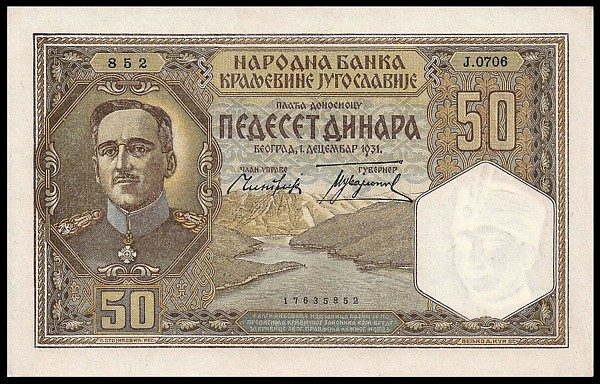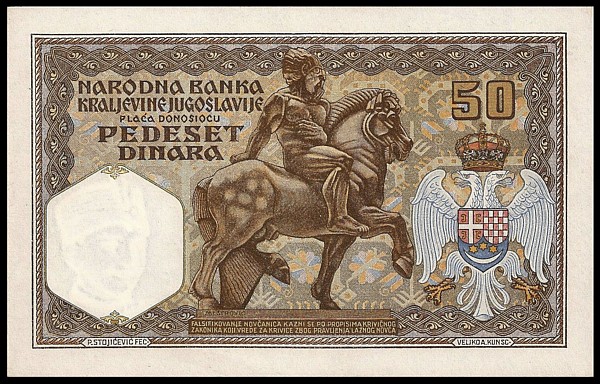Yugoslavia
Alexander I
50 Dinara 1931 P-28

This Yugoslavian banknote portrays the portrait of King Alexander on the left with a vignette of the bay of Kotor at center. A watermark of the king is at right.
On December 16, 1888, Alexander Karađorđević was born into a Serbian royal family that was in exile, and a life of what could be described as a royal mess. His mother died in 1890 while giving birth to a child who died only days later. His older brother George would prove to be a bit of a problem later on, and another brother who died at birth. He had two older sisters as well, Helen, and a baby who died in infancy.
Alexander’s grandfather had been forced to abdicate the throne in 1858. 45 years later, in 1903, Alexanders father Petar would eventually get it back by authorizing a coup known now as the May Overthrow, but he was again put into exile during WWI.
During most of the troubled time his family was in political strife, Alexander was sent off to boarding schools in Switzerland and later in Russia. Once his father had regained the crown Alexander returned to Serbia to finish his studies.
In 1909, for reasons now unknown, Alexander’s brother George was in a rage and when he kicked a servant in the stomach which killed him. Already seen as impulsive and rash by many, this proved to be so unpopular with the public that George had to renounce his claim to the throne, though he did not serve any other punishment. This incident placed Alexander in direct line to the throne. Later on George would try several times to recant his renunciation of his claim to the throne, but he never succeeded.
Three years later there were wars to be fought. Known as the First Balkan War in 1912 and the Second Balkan War in 1913, Alexander served in the army, taking part in a small number of battles in each one. After these wars there were decisions to be made on how to deal the Macedonian administration. Alexander found himself at odds with a Colonel Dimitrijević over this topic and, in the end, Alexander’s plan succeeded. This was a key component to King Petar making his son the Regent of Serbia in June, 1914. This effectively gave his son the power of being the King without the full title.
On June 28, 1914 a Serbian student named Gavrilo Princip assassinated the Austrian Archduke Ferdinand. The intent was to help gain some independence of southern Austro-Hungarian provinces, but this was just the spark needed to ignite the European war that would affect the entire globe. War was again imminent: this time World War 1. Though he was in charge of the nation and the military, Alexander’s military role was more of a figurehead.
Despite some initial military successes, the military succumbed to enemy forces and retreated to Corfu, a Greek island, where it was able to reform itself. Towards the end of the war in 1918, the Serbian army did have some final battlefield success in Macedonia.
In July 1919 King Petar returned to Belgrade, staying there until his death in 1921, whereupon Alexander assumed the title of King. In 1922 he married the Romanian Princess Maria, and would go on to have three sons with her.
Alexander’s brother George also served in WWI with distinction, and was badly wounded. To the public, this action seemed to make up for his earlier crime of kicking his servant to death and he became rather popular in the press. Alexander grew afraid of his brothers growing public support and suspected that he might attempt to take over the throne. When his fear grew too great, Alexander had his brother George arrested in 1925 and then had him declared insane. The result was that George remained locked in his asylum until released by the German occupying forces during World War II. Meanwhile, as King, Alexander made a number of changes. Alexander said that these changes were only temporary, and were in place to allow the country to become unified in a Yugoslav ideology. This ideology had its inception in the 1830’s and claimed that the southern Slavic peoples were their own ethnic group and belonged to a Yugoslavic empire. This ideology had been kept in check by the Ottoman and the Austro-Hungarian empires, but after the Balkan Wars and WWI, there was no-one to stop it.
In January of 1929 Alexander had the parliament suspended, and created a cabinet that would answer only to him. He then abolished the constitution and placed strict censorship in news outlets and declared that the Cyrillic alphabet was to be abandoned in favor of the Roman alphabet. These moves allowed him to become what is called a Royal Dictator as there were no constitutional limits nor was there a parliament to be elected which could restrain his personal powers. Then in October 1929 Alexander changed the name of the Kingdom of Serbs, Croats and Slovenes to the Kingdom of Yugoslavia.
In furthering his vision of Yugoslavia, Alexander later developed a new constitution which gave him complete executive power.
In a 1934 trip to France, Alexander was headlined to a political meeting seeking support for a military treaty to thwart any future rise of the Hungarian nation against the Slavic people. Like with Archduke Ferdinand of Austria, King Alexander was in a slow moving motorcade. This time it was a Bulgarian assailant seeking independence from Yugoslavia who fired two shots, killing the Yugoslavian King. The assailant fired his gun a total of 15 times, and was eventually killed by the surrounding crowd.
After the German forces invaded in WWII, Alexander’s brother George was finally released from his mental asylum. There was no longer any ability for him to be reinstated as a ruler, but he lived out his life, if not a king, at least he was free. He married in 1947, but never had children on his own.
Located in modern day Montenegro, the city and Bay of Kotor, pictured center, is renowned as one of the most beautiful European spots. The Bay of Kotor, with its mighty mountains, ancient waterfront and blue water coves has also been declared a UNWSCO World Heritage Site. One can view a panorama of the city and bay from the medieval fortress.


The back of this banknote shows a statue of Marko Kraljević who, in 1371 succeeded his father as king of Serbian dominated lands in modern day Macedonia. Though he was a king, he was suzerain to the Ottoman Empire, ruling his lands but still under the control of the Ottoman rulers. His reign was full of troubles however, especially from other Serbs who did not recognize his authority. He had many rivals and lost much of his lands.
It is somewhat odd then that Marko gained fame in Serbian Poetry, often sung to the Serbian stringed instrument the Gusle. In these poems, the Marko of poetry is far off from the Marko of reality. While there is little historical accuracy in the poems, they do maintain his responsibility for the decline in Serbian autonomy.
Still, he is portrayed in verse as a champion of the poor and helpless Serbs, fighting against an unjust Ottoman authority. He is immortalized as rescuing Serbs from dungeons, killing tyrants, helping princesses, and being kind to animals. Though the poems do portray him as being vassal to the Ottomans, it was always an uneasy alliance, with the sultan being shown as the weaker man.
Many of the poems and legends portray Marko as being inseparable from his horse, Šarac. One legend has it that Marko, who in lore had incredible strength, was looking for a horse to carry him on his journeys. While looking at horses, he would test them all by grabbing them by the tail and tossing them over his shoulders. None seemed to be good enough until one day when Marko saw a sickly horse with a dappled coat. Marko grabbed its tail, but he could not move him! Marko bought the horse and nursed it back to health, and the two became constant companions. Their statue on the banknote was created by Ivan Meštrović in 1910.
The double-headed eagle is a symbol that few seem to know anything about. This mysterious animal is actually an ancient symbol dating back to the Hittite kingdom about 1900 BC.
One of the meanings behind it is that it is a messenger between God and the rulers of the people, delivering messages straight from the heavens. The two heads represent both the power of the material world and divine protection. As such, it represents the power of a ruler in both secular and religious dealings. As it looks in two directions, it has also become a symbol of domain over the east and west.
